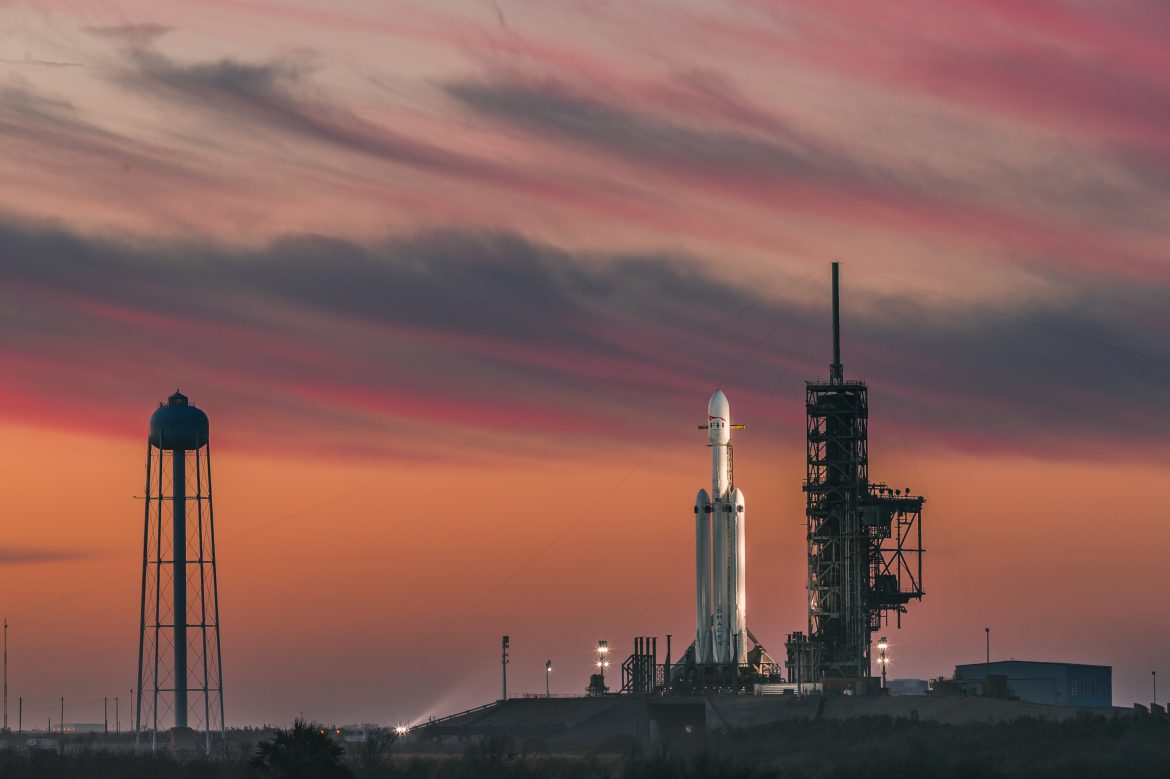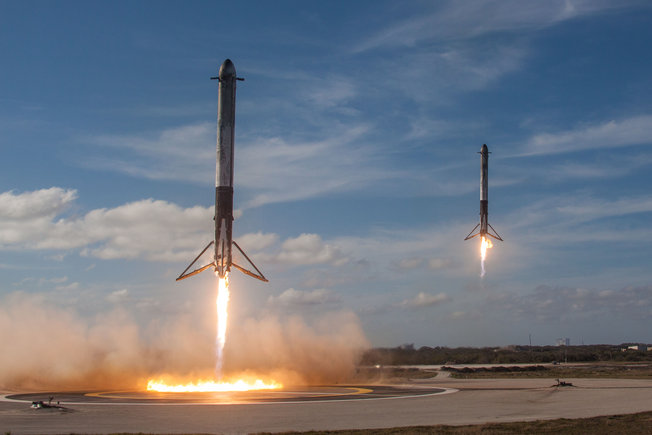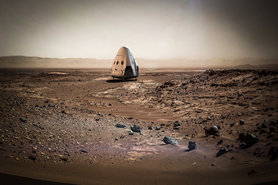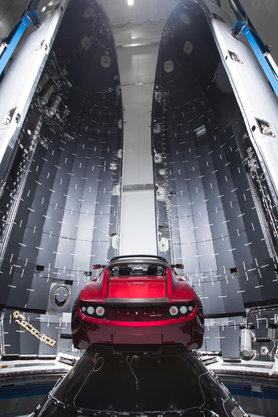
Falcon Heavy: A New Dawn for Space Exploration?
Earlier this year SpaceX test launched Falcon Heavy, the most powerful operational rocket in decades. For SpaceX’s founder Elon Musk, Falcon Heavy brings people one more step closer to living on other planets. Whether his ultimate goal succeeds or fails, under Musk’s leadership SpaceX has undeniably revolutionized rocket reusability, intensified competition and injected much-needed public excitement into space exploration. But is Falcon Heavy truly a giant leap for space exploration?
Later this summer a curious, ring-shaped satellite will be carried some 12,000 km above the Earth where, if all goes well, it will spend the next three years studying the harsh radiation environment of a band of space known as medium-earth orbit. The spacecraft, DSX (Demonstration and Science Experiments), has been ready to launch since 2009 but has struggled to find space on a suitable rocket. Although described as a ‘small spacecraft’, the satellite weighs over half a ton and will orbit the earth much higher than most satellites. Until recently, booking a place on one of the few rockets powerful enough to send a spacecraft onto such an unusual orbit has been difficult and expensive. This all changed on 6 February 2018 with the successful test-launch of SpaceX’s Falcon Heavy rocket.
A new era of giant rockets
When Falcon Heavy cleared the launchpad at 15:45 EST (20:45 UTC) on a sunny Florida afternoon, it became the largest, most powerful rocket to lift off from the Kennedy Space Center since NASA’s giant Saturn V rocket in 1973. Eight minutes later, the two side booster rockets simultaneously touched down on landing pads 150 meters apart at Cape Canaveral ready to be refueled and reused. While much of the media excitement surrounding the test-launch has focused on a convertible red sports car and its dummy passenger, the success of the mission marked several exciting landmarks for science and the space industry.
Falcon Heavy is the first launch vehicle since the 1970s with enough lifting power to take humans beyond low-earth orbit. Indeed, it is one of only very few heavy lift rockets currently in operation (the others are Ariane 5, Delta IV Heavy, and Proton-M). More importantly, Falcon Heavy is largely reusable and, by comparison, very cheap. The successful return and touchdown of Falcon Heavy’s booster rockets means the cost of delivering large payloads into orbit will be considerably lower than its nearest competitors: about half the cost per kilogram of Russia’s Proton M rocket.
Yet the test launch was significant for more than just payload and cost. Love him or hate him, Elon Musk has helped bring space exploration back into the public imagination. The launch was watched live on YouTube by over 2.3 million people, surpassed only by Felix Baumgartner’s Red Bull Stratos skydive in 2012 and the Royal Wedding in 2011. And if a giant rocket being pulled into the sky wasn’t surreal enough, the simultaneous return landing of the two side booster was as graceful as a carefully choreographed dance. This was history, science fiction, and art, all unfolding on millions of screens around the world.
What does this mean for science and space exploration? Is this really the dawn of a new age of low-cost commercial space flight? Or are we simply applauding the eccentricities of billionaires while they blast money into space in the name of spectacle? To find answers we need to dig a little into the history of SpaceX, the Falcon rocket, and today’s commercial space industry.
Space X was founded in 2002 with the goal of one day allowing people to live on other planets. According to Musk, this means restoring public interest in space exploration, increasing NASA’s budget, and vastly reducing the cost of space flight. In just over fifteen years the company has come far. From 160 employees in 2005 it has grown to almost 7,000. The company has seen fifty-two successful rocket launches, was recently valued at $21.5 billion and has been contracted to fly another forty-five commercial missions in 2018 and the coming years.
The Falcon rocket family
The rocket itself is the latest addition to the Falcon rocket family. The first Falcon rocket was conceived back in 2001 after Elon Musk failed to find an affordable rocket to send a miniature greenhouse to Mars. Deciding it would be cheaper to build his own rocket, Musk founded SpaceX and Falcon 1 was born.
When Falcon 1 lifted off on 28 September 2008, it became the first privately-developed liquid fueled rocket to reach orbit. The larger Falcon 9 (the number refers to the number of first-stage engines powering the rocket) quickly became the company’s workhorse rocket. Since 2010 SpaceX has launched forty-nine commercial payloads using Falcon 9 rockets, including fourteen resupply missions to the International Space Station (ISS) using the company’s Dragon capsule.
Essentially, Falcon Heavy is a modified Falcon 9 rocket with two additional Falcon 9 rockets strapped to either side. A total of twenty-seven first stage Merlin engines mean the rocket can comfortably carry 64 tons to low-earth orbit – forget sports cars, that’s a 737 airliner including passengers, fuel, cargo, and savoury snacks. By comparison, the European Space Agency’s Ariane rocket carries 21 tons, Russia’s Proton-M rocket 23 tons, and the US-backed Delta IV Heavy rocket 29 tons.
But the real innovation of the Falcon rockets (and the giant leap for commercial space flight) is reusability. All Falcon 9 rockets (including Falcon Heavy) are two-stage rockets. After separation the first stage turns around and conducts a powered landing at a predetermined landing site. The rockets are cleaned, tested and ready to fly again within a couple of weeks. Since March 2017 SpaceX has sought to return and reuse every first stage rocket. In fact, the two side rockets used on the Falcon Heavy test launch were both reused rockets. Two months earlier, in December 2017, SpaceX resupplied the International Space Station (ISS) using a reused Dragon spacecraft atop a reused Falcon 9 rocket – soot from the rocket’s previous launch was still visible on the rocket when it launched. This approach has had a huge impact on the cost of each rocket.
The shifting cost of space transportation
Comparing Falcon Heavy with its nearest competitor, United Launch Alliance (ULA)’s Delta IV Heavy, gives a sense of the step-change underway. Even in an expendable, maximum performance configuration, a Falcon Heavy rocket is expected to deliver up to 64 tons to low-earth orbit (LEO) for $150 million, or $2,300 per kilogram of payload. A Delta IV Heavy rocket currently costs $350 million and carries only 28.7 tons, working out to $12,100 per kilogram of payload. In its fully reusable configuration a Heavy Falcon rocket can still lift 53 tons to orbit, but costs only $90 million, or $1,700 per kilogram. Even if we look at the most affordable rockets on the market such as Russia’s Proton M, the cost per kilogram is around $2,800 so almost forty percent more expensive than SpaceX. Even more striking, back in the days of the Space Shuttle, the cost per kilogram was closer to $60,000.
Of course, these figures require a measure of scepticism. Although SpaceX advertises Falcon Heavy delivered payloads as low as $1,100 per kilogram, there is very little transparency on the breakdown of these costs. Equally, the payload, rocket reliability (i.e. insurance cost), required orbit, and launch window all raise or lower the launch cost. Regardless, the shift is striking, revealing both how far space transportation has advanced as an industry and an indication of the intense pressure SpaceX is bringing to the market.
This pressure will continue to increase. Reusability for the second stage and payload fairings (the shell surrounding the payload on the top of the rocket) are in development and will, if completed, further reduce the cost per launch of Falcon rockets. What’s perhaps more exciting, development on SpaceX’s BFR (or Big Falcon Rocket) has progressed rapidly with testing to begin in 2019 aiming for a 2022 launch date. BFR will eventually replace all Falcon rockets and according to SpaceX, could bring the cost of space flight down to consumer levels. Doing so is key to SpaceX’s mission to bring people to Mars and will continue to disrupt the existing space industry.
SpaceX: the ultimate disruptive start-up
So how have SpaceX managed to develop such a radically competitive rocket? Obviously, reusability is enormously important. SpaceX’s organizational philosophy, however, has also kept costs down by developing as much as possible inhouse and acting as its own supplier rather than working with contractors. Although a private company, SpaceX is not driven solely by profit, growth and dividends (at least not yet). Musk established SpaceX with the belief that living on other planets can only be achieved by lowering the cost of space flight. Other commercial players in the space industry such as ULA (a Boeing and Lockheed Martin partnership) earn their business by winning expensive government contracts. Let’s compare these corporate visions and aspirations. Boeing: “Best in Aerospace and Enduring Global Industrial Champion.
Lockheed Martin: “Be the global leader in supporting our customers' missions, strengthening security and advancing scientific discovery.”
SpaceX: “Let’s live on other planets.”
This is paraphrasing of course but the point remains that while Boing and Lockheed Martin have made enormous contributions to science and technology they are driven by their customers and the industry within which they operate. Further, both are public companies so are under pressure to maintain a healthy share price based on short term profits. When applied to the space industry where most money comes from government, this framework risks rewarding delays and cost overruns. When applied to other government-funded industries, say defence, you need look no further than another Lockheed Martin project, the F35 Lightning II, to see how a contracted project can become mired in endless delays, obsolescence, and ballooning costs.
SpaceX, on the other hand, will only succeed in its mission to reach other planets by finding the shortest route to the most affordable space launch system. This is why in barely two decades SpaceX already has two reliable, reusable, low-cost launch systems and can already outperform all its competitors in cost, capability, and scale.
Of course, developing Falcon Heavy was never as simple as strapping three rockets together. The engineering and aerodynamic challenges nearly cancelled the project several times and to date has cost around $500 million. Alongside the $1 billion reportedly spent developing reusability for the Falcon rockets it certainly seems like a lot of money. However, when you compare it to the cost of NASA’s future SLS ($19 billion and counting) the amount seems trivial. Yes, Falcon Heavy is years late and cost a great deal to develop, but when you compare these costs and overruns to those of its nearest competitors you really begin to wonder how everyone else has got it so wrong.
SpaceX funding
‘Loose change’ or not, these are still billions of dollars of investment. So where has this money come from? Today, the company’s primary source of revenue is commercial contracts for launching payloads into space. Getting the company started, however, was no easy task. Funding to kickstart SpaceX came from several sources including venture capital firms and private investors such as Google (which bought 10% of the company for $700 million in 2015). Less frequently reported sources of investment include funding from the US state of Texas to build a new commercial spaceport at Boca Chica, Texas. As an investment in the state’s ‘space infrastructure’, SpaceX will receive at least $15 million from state funds to develop the spaceport. Other states have also contributed to SpaceX’s many launchpads and testing sites, including Florida which spends around $20 million each year funding ‘space infrastructure’ (shared among several companies including SpaceX). And then of course there is Elon Musk himself who invested around $100 million of his own money to get SpaceX off the ground.
As both customer and timely benefactor, the real key to SpaceX’s success is NASA. Although NASA did not directly fund Falcon Heavy, the billions of NASA dollars SpaceX received for commercial contracts certainly helped! In fact, well-timed NASA contracts have saved the company from bankruptcy on several occasions. Probably the most pivotal NASA intervention came towards the end of 2008. By December, with hundreds of millions of dollars already spent on development, SpaceX had run out of money. The global economy was in meltdown and SpaceX had no revenue earning product: unsurprisingly, new investors were hard to find. With his other venture also struggling, Musk faced the very real prospect of abandoning SpaceX to save Tesla. As the end of the year arrived and time ran out, NASA announced a $1.6 billion contract for SpaceX to deliver cargo to the ISS. There is no doubt this decision allowed SpaceX to finish developing the Falcon 9 rocket and Dragon space capsule and very likely saved the company.
Falcon Heavy Test Launch
In the end the Falcon Heavy test launch went as well as anyone could hope. On a gloriously sunny Tuesday afternoon at Kennedy Space Center, Florida, the 70-metre-tall rocket sat shrouded in clouds of steam and vapour. During the final seconds of countdown water towers dumped thousands of litres of water around the base of the rocket (the water protects the rocket by dampening sound vibrations from the engines during lift-off, creating the enormous cloud of steam you see during lift off). Seconds later the rocket’s twenty-seven Merlin engines roared to life and Falcon Heavy was carried up on a pillar of rising fire. Over the next two and a half minutes the rocket powered into the sky, enduring incredible aerodynamic stresses as it climbed through the atmosphere. Some 60 km above the earth and travelling at just under 7,000 km/h the side boosters shut down and separated, falling back towards the Earth. The central booster continued to burn for another 45 seconds before it too detached and fell away. Less than a minute later the second stage and payload were over 120 km above the earth travelling at over 10,000 km/h. The vehicle’s faring opened to reveal the now famous Starman sitting at the wheel of Elon Musk’s cherry-red Tesla roadster floating gracefully above the Atlantic Ocean.
Meanwhile, the three first-stage boosters fell slowly back to earth shooting little jets of propellant to correct their descent. Just eight minutes after blasting-off into the sky, the two side boosters rocketed down side-by-side for a perfect synchronized touchdown.
As for the middle booster, it ran out of fuel and struck the ocean at a resounding 480 km/h. Responding to the crash landing Musk tweeted:
‘Not enough ignition fluid to light the outer two engines after several three engines relights. Fix is pretty obvious.’
This wasn’t the only hiccup of the mission. Six hours after launch, the second stage performed its third and final burn. However, the rocket overshot and instead of cruising past Mars, the dummy payload is now on its way to the asteroid belt on an elliptical orbit reaching almost as far as Ceres (the largest body in the asteroid belt).
Better, faster, cheaper
Musk has stated before that he wants SpaceX to remain a private company, at least until the company is flying regular flights to Mars. According to the South African billionaire, opening SpaceX up to public ownership would mire the company in short-term profit-making activities. Instead the company seems to be bringing a variation of Moore’s law to the space industry in pursuit of a distant ideal to colonize other worlds. In the last decade of the 20th Century, NASA adopted a new initiative to respond to crippling budget cuts while keeping its space exploration activities alive. The approach was known as ‘better, faster, cheaper’ and attempted to radically change how the agency worked – in the words of one employee, ‘going further and faster with fewer people and with a smaller budget’. The approach produced some spectacular results but as the agency increasingly contracted out services and resources to the private sector it was hit by several devastating incidents including the Columbia Space Shuttle accident, claiming the lives of seven astronauts. Soon after, the approach was abandoned. Although NASA continues to reach incredible milestones, it is in much less of a hurry to do so. As one of the chief sources of funding for the space industry, NASA’s flat approach seems to have permeated across the entire industry.
For better or worse, SpaceX has reintroduced ‘better, faster, cheaper’ to the space industry. Whether the company will continue to demand more from the industry, or crash and burn remain to be seen. What we can say is that the cost of flying to space will continue to fall and offer spacecraft such as DSX, scheduled to fly on a Falcon Heavy rocket later this year, a chance to finally reach the stars.
Shortly after lift-off on 6 February, Musk ran outside to join SpaceX employees and spectators watching the test-launch of Falcon Heavy. He pointed at the sky with childlike wonder,
“That’s unreal” he said.
Isn’t it just.
REFERENCES
- 1. http://www.spacex.com/sites/spacex/files/falconheavypresskit_v1.pdf
- 2. http://www.spacex.com/sites/spacex/files/crs13presskit12_11.pdf
- 3. http://www.nss.org/articles/falconheavy.html
- 4. http://pintleinjector.blogspot.com/2016/12/pintle-injector.html
- 5. https://www.space.com/36296-spacex-completely-reusable-falcon-9-rocket.html
- 6. https://www.nasaspaceflight.com/2018/02/spacex-debut-falcon-heavy-demonstration-launch/
- 7. https://www.nasa.gov/missions/shuttle/f_watertest.html



